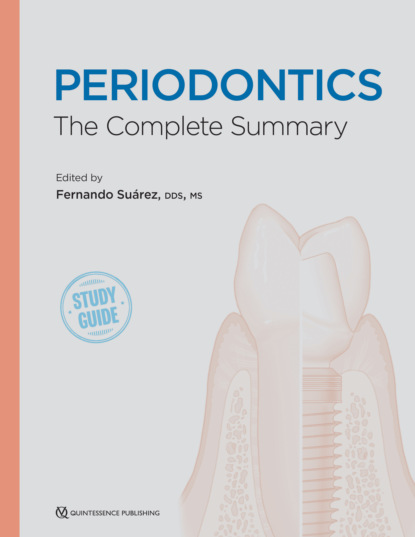to the gingival margin, often brown or black, hard and tenacious. Also known as seruminal calculus.1
Supragingival calculus: Calculus formed coronal to the gingival margin, usually formed more recently than subgingival calculus. Also known as salivary calculus.1
Cemental tears: A specific type of root surface fracture and characterized by the detachment of a cemental fragment.2
Cementicles: Calcified spherical bodies (0.2 to 0.3 mm) composed of cementum lying free within the periodontal ligament, attached to the cementum, or embedded within it.1,3–6
Crowding: Discrepancy between tooth sizes and arch length and/or tooth positioning that results in malalignment and abnormal contact relationships between teeth.1
Enamel pearl: A focal mass of enamel that has formed apical to the cementoenamel junction (CEJ) and is typically located in the areas between the roots of molars.1
Enamel projection: An apical extension of enamel, usually toward a furcation.1 May prevent true attachment of periodontal ligament fibers upon the root surface.7
Exostosis: A benign bone growth projection outward from the surface of a bone.1
Furcation: Anatomical area of a multirooted tooth where the roots diverge.1
Furcation arrow: A radiographic shadow associated with a proximal furcation.8
Furcation entrance: Transitional area between the undivided and the divided part of the root.9
Furcation fornix: Roof of the furcation.9
Furcation involvement (invasion): Pathologic resorption of bone within the furcation. The extension of periodontitis or pulpitis into a trifurcation area.1
Impacted tooth (impaction): An unerupted or partially erupted tooth so positioned that complete eruption is unlikely.1
Intermediate bifurcational ridge (IBR): A distinct ridge running across the bifurcation in a mesiodistal direction.10
Overhang: Excess of dental restorative material extending beyond cavity margins.1
Palatal groove: A developmental, anomalous groove usually found on the palatal aspect of maxillary central and lateral incisors.1
Plunger cusp: An active passage of food into the embrasure area during function.11
Plaque: An organized mass, consisting mainly of microorganisms embedded in a matrix of glycopolymers, that adheres to teeth, prostheses, and oral surfaces and is found in the gingival crevice and periodontal pockets. Other components include an organic, polysaccharide-protein matrix consisting of bacterial by-products such as enzymes, food debris, desquamated cells, and inorganic components such as calcium and phosphate.1
Root complex: Portion of a tooth apical to the CEJ.9
Root concavity: Developmental depressions as cratered, valley-like shapes in the root surface.12
Root cone: Divided region of the root complex.9
Root proximity: Closeness of roots of adjacent teeth typically associated with inadequate interdental tissue.1
Root surface area: Area available for periodontal attachment.13
Root trunk: Undivided region of the root between the CEJ and furcation.9
The anatomy of the dentition differs significantly based on multiple factors, including but not limited to tooth type, number of roots, location of the furcation entrance, root trunk length, total root length, and root divergence/convergence. In addition, different local characteristics may alter or influence these anatomical variations. A comprehensive understanding of the tooth morphology and tooth-related factors that may influence or predispose periodontal breakdown is paramount for an accurate diagnosis and treatment plan. This chapter includes a comprehensive description of the evidence on the role of these factors in periodontal diseases.
Biofilm and Calculus
Biofilm formation is a progressive and dynamic process that facilitates bacterial attachment to tooth structures through van der Waals forces, glycocalyx, and lectin-like receptors within a salivary pellicle and negative surface charges mediated by teichoic acid of gram-positive bacteria.14–16 The shift from gram-positive to gram-negative bacteria occurs as subgingival plaque develops and is influenced by biofilm thickness and gingival crevicular fluid. The process of mineralization of biofilm into dental calculus has been suggested by Genco et al16 to undergo four theoretical processes: booster mechanism, epitaxic concept, inhibition theory, and transformation theory.
The inorganic and organic composition of dental calculus have been extensively explored.17–28 Major inorganic components of dental calculus are calcium, phosphorus, carbonate, sodium, magnesium, potassium, and trace elements such as fluoride and zinc.16 Moreover, four major crystalline forms can be noted within mature calculus, including hydroxyapatite, octacalcium phosphate (OCP), whitlockite (WHT), and brushite.18,20,22 On the other hand, proteins (50%–60%), carbohydrates (12%–20%), and lipids (10%–15%) represent about 15% to 20% of the dry weight of mature supragingival plaque.29 Major differences in the characteristics of dental calculus exist depending on the location. Table 5-1 summarizes the characteristics of both supragingival and subgingival calculus.30
TABLE 5-1 Characteristics of supragingival and subgingival calculus*
| Supragingival | Subgingival | |
| Location | Coronal to gingival margin | Apical to gingival margin |
| Color | Yellow/white | Brown/black |
| Distribution | Adjacent to salivary duct openings | Randomly around the oral cavity |
| Composition | Low concentration of Ca, Mg, F, Sr, and ZnHigh concentration of carbonate and Mn | High concentration of Ca, Mg, and FLower concentration of carbonateMore irregular distribution of F |
| Mineral content and source | Average of 37% from saliva by volume | Average of 58% from gingival crevicular fluid by volume |
| Crystal type | Mostly OCP and hydroxyapatite | Mostly WHT |
| Formation | Heterogenous nucleation and crystal growthMore variable calcification | Heterogenous nucleation and crystal growthMore homogenous calcification |
| Microorganisms | More filamentous, faster growing | Less filamentous, slower growing |
| Morphology | Heterogenous with small needle-shaped (100 nm), large-ribbon-like and bundle/rosettes (1–50 nm) crystals | Several crystal types (< 50 nm): spiny, crusty, nodular, ledge/ring, individual islands, smooth veneers and finger/fern-like |
| Pathogenic potential | Little evidence | Associated with periodontal disease |
*Adapted and modified from Roberts-Harry and Clerehugh.30
Ca, calcium; Mg, magnesium; F, fluoride; Sr, strontium; Zn, zinc; Mn, manganese; Na, sodium.
